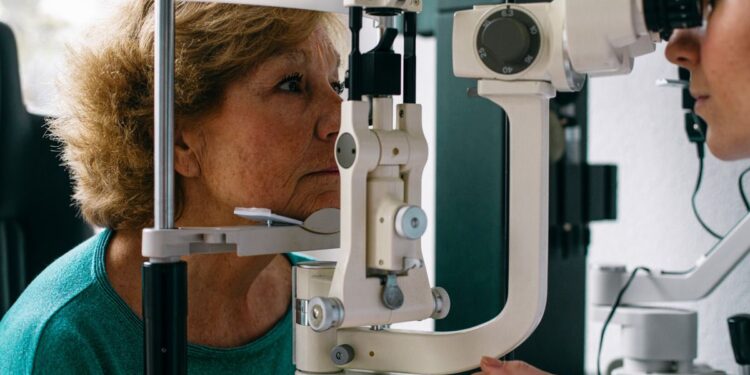
- GLP-1 drugs are associated with a higher risk of “wet” age-related macular degeneration in people with type 2 diabetes, according to a new study.
- Researchers found that the risk substantially increased the longer people were prescribed a GLP-1 drug, particularly those containing semaglutide.
- GLP-1 medications like Ozempic and Wegovy have surged in popularity as weight loss treatments, but ophthalmologists say their potential risks to eye health are not well understood.
GLP-1 drugs are linked to a significantly higher risk of developing neovascular or “wet” age-related macular degeneration, according to new research.
The study, conducted by researchers at the University of Toronto, found that people with type 2 diabetes who were prescribed GLP-1s were more than twice as likely to develop wet AMD as those who weren’t. The study also found that the longer subjects were treated with these medications, the greater their risk of developing wet AMD.
Neovascular age-related macular degeneration, commonly known as wet AMD, is the less common but more aggressive form of age-related macular degeneration, and a leading cause of irreversible vision loss among older adults in the United States.
The findings, published on June 5 in
While the findings don’t establish a clear causal link between GLP-1 drugs and eye disease, experts say there’s still reason for caution.
“The dose-response effect we observed — where longer GLP-1 receptor agonist exposure was associated with higher risk — strengthens the argument that this association may reflect a true biological effect rather than being due to confounding factors,” said study co-author Andrew Mihalache, MD(C), of the Temerty Faculty of Medicine at the University of Toronto, Canada.
“Seeing a graded relationship like this suggests that prolonged exposure could play a causal role in increasing risk. However, this needs to be confirmed in future studies,” he told Healthline.
Drawing on health records from Ontario, Canada, researchers at the University of Toronto analyzed nearly 140,000 adults with type 2 diabetes to investigate a possible link between GLP-1 use and wet AMD. The retrospective study tracked patient outcomes over a three-year period, using data collected between 2020 and 2023.
Roughly one-third of participants — about 46,000 people — had been prescribed a GLP-1 drug for at least six months. The rest had not.
In the vast majority of cases (97.5%), that drug was semaglutide, the active ingredient in Ozempic and Wegovy.
The average participant was 66, and the cohort was almost evenly divided by sex, with females representing 46.6% of the group.
On average, those who were prescribed a GLP-1 drug were more than twice as likely to be diagnosed with wet AMD.
However, that number doesn’t tell the full story. People who took GLP-1 drugs for longer experienced progressively greater risk. Those who had only taken their medication for 6–18 months actually had a slightly lower risk than those who didn’t take the medication.
However, at the 18–30 month mark, GLP-1 users’ risk of developing wet AMD more than doubled compared to non-users. And those taking the drugs for 30 months or longer had more than triple the risk.
“This was definitely surprising, especially given the growing enthusiasm for GLP-1 receptor agonists for their cardiovascular and metabolic benefits. It really highlights the need for further investigation into their ocular safety profile,” first study author Reut Shor, MD, of the Department of Ophthalmology and Vision Sciences at the University of Toronto, Canada, told Healthline.
Despite the increase in risk, the absolute risk of developing wet AMD was still low: 0.2% among those taking a GLP-1 and 0.1% among those who didn’t.
While not definitive, the study raises further questions about the potential risks posed by GLP-1 drugs for eye health.
Prior studies have also identified links between GLP-1s and other forms of eye disease in people with type 2 diabetes.
In a major phase 3 semaglutide trial in 2016, researchers identified that type 2 diabetes patients taking semaglutide had a higher risk of complications of diabetic retinopathy compared to a placebo. Those findings were published in
However, other studies have provided conflicting evidence. A retrospective 2024 study evaluated nearly 700 subjects with type 2 diabetes who were taking a GLP-1 drug and found no association between GLP-1s and worsening retinopathy.
The mechanism for why GLP-1 drug use may lead to wet AMD is not well established, but a predominant theory is that lowering blood sugar rapidly leads to a lack of oxygen in the retina.
“When you make the retina more hypoxic, which is what the GLP-1s do, it basically pushes it further over the threshold, causing more abnormal blood vessels to grow,” said Linda Lam, MD, MBA, an ophthalmologist with Keck Medicine of USC, who wasn’t involved in the research.
Abnormal blood vessel growth in the eye is the hallmark of wet AMD.
While GLP-1s offer many health benefits, eye disease risk must be considered in some populations, Lam told Healthline.
“In this particular group of patients who are older, who are diabetics, I really would caution against the extended use of GLP-1s,” she said.
Lam reiterated the importance of annual eye exams for the general population, but in particular for those with diabetes, to identify and diagnose eye disease early on.
People with type 2 diabetes, especially those taking a GLP-1 drug, should be aware of the signs and symptoms of vision loss and consult with their doctor immediately. These include:
- distortion or blurriness in the central area of vision
- objects having a curved or wavy shape (metamorphopsia)
- new blind spots
- difficulty with tasks such as reading or driving
- difficulty recognizing familiar faces
Source link : https://www.healthline.com/health-news/glp-1-drugs-age-related-macular-degeneration-risk
Author :
Publish date : 2025-06-06 16:50:55
Copyright for syndicated content belongs to the linked Source.














